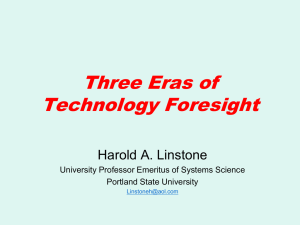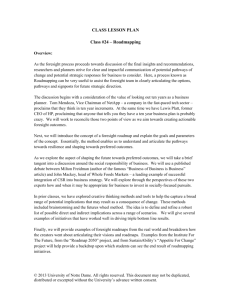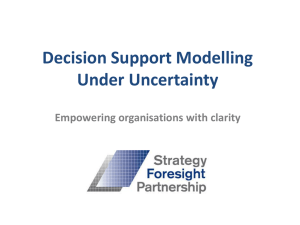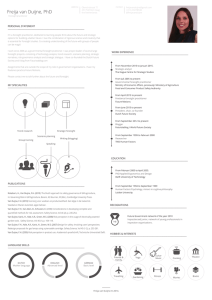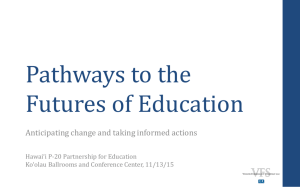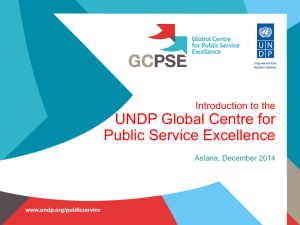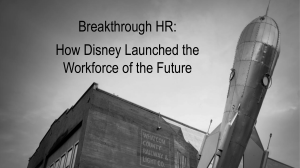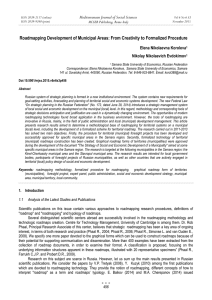A Role for Science & Technology Foresight in CTBT-ISS?
advertisement
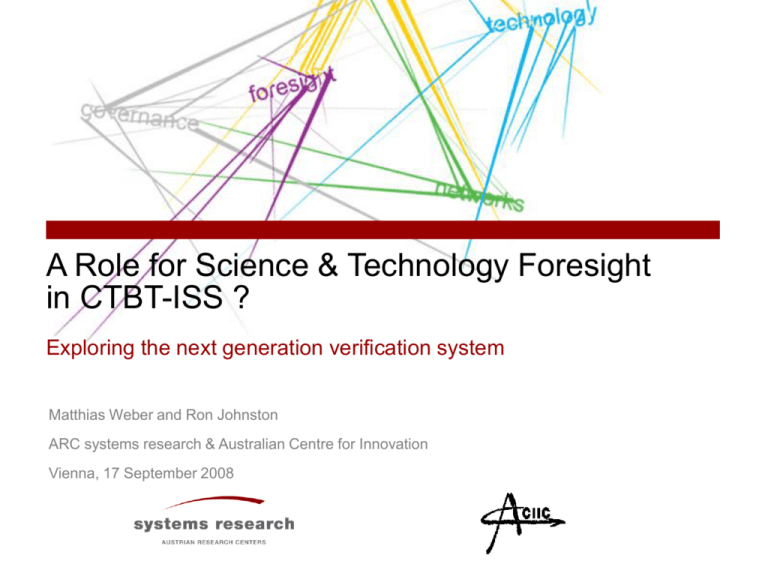
A Role for Science & Technology Foresight in CTBT-ISS ? Exploring the next generation verification system Matthias Weber and Ron Johnston ARC systems research & Australian Centre for Innovation Vienna, 17 September 2008 Overview The context for a CTBT-ISS S&T Foresight initiative The landscape of S&T Foresight methods Experiences with S&T Roadmapping Key issues for a CTBT-ISS S&T Foresight initiative © systems research The global context for CTBT-ISS Geopolitical shifts E.g. new entrants/exits to the “nuclear club” International agreements and regulations E.g. early detection of nuclear disasters Shifts in perception of risks E.g. greater focus on climate change and natural disasters Financial pressures E.g. budget cuts Scientific advances E.g. infrasound Technological advances E.g. IT-based communication and computation advances © systems research The local context for a CTBTO S&T Foresight Shift from building up a verification system to operating, maintaining and upgrading it Emerging needs and opportunities Assess appropriateness of the existing system to meet its future tasks Continuous monitoring of emerging S&T opportunities Consensus-building on the introduction of novel elements Integration into the existing system Spill-over potential into other problem areas (e.g. natural disasters) © systems research The local context for a CTBTO S&T Foresight (2) Three stakeholder communities to consider Preparatory Comission CTBT-ISS Scientific communities S&T Foresight as a process-based instrument to deal with emerging needs and opportunities in interaction with stakeholder communities © systems research Forecasting – Foresight – Planning What is the difference? Forecasting supposes that there is one possible future, based on extrapolation or projections of past and present trends. Involves only experts. Time horizons commonly 5-10 years. Foresight assume that there are many futures, and through the mobilisation of interested stakeholders it is feasible to develop a fuller understanding of the forces shaping the long-term future. It uses time horizons of 1020 years. Planning is based on theories or doctrines on future developments. Involves only policy makers and experts. Time horizons between 1-5 years. © systems research Landscape of Future Studies Focus on Markets and Business Environments (economic, political, societal, ecological) = non-technological driving forces Scenarios of Future Societies (e.g. Political think tanks) Strategic Marketing and Trend Research Strategic Market Research (Conventional market research Global Trends (e.g. World Bank, Worldwatch Institute) Prospective Economic Analyses + 5 years Today Competition Analysis + 10 years + 15 years Innovation and Technology Analysis Product Impact Assessment Technology Assessment Technology (e.g.Offices for technology Monitoring Strategic assessment) Technology Monitoring Technology Foresight (e.g. Delphi-Studies, Focus on Technologies Technology Monitoring) Source: F. Ruff © systems research Methods & Tools Diagnosis Prescription Prognosis Environmental Scanning/Monitoring Trend Extrapolation Modelling and Simulation Scenario Building © systems research X X X XX X X Roadmapping Critical/Key Technologies X XX X XX X X X X X X XX XX Normative X X Expert Panels Delphi Survey Quantitative XX Exploratory Qualitative X X Predictive X X X X X X X X X XX X X XX X X X X X X X X Two basic approaches to Foresight Exploratory approach: what would we expect to happen if this event happens or if that trend develops? Knowledge about the present What if Alternative futures Normative approach: what to do now to make the „best future“ happen? The „best future“ Present actions © systems research Alternative futures Source: Keenan/PREST Application of the foresight methodology Establishing a transparent structured decision-making process Introducing a forward-looking attitude – anticipative intelligence Provoking a creative and motivating decision making environment Stimulating a participative approach Enabling mutual learning and strategic dialogue Reaching consensus around shared visions Linking technology and innovation to wider socioeconomic issues Paving the way for coordinated/coherent action Source: Keenan/PREST © systems research S&T Roadmapping (STRM) as an option for CTBT-ISS? A STRM is a process tool to help identify the key scientific and technological development that an industry/sector/company/organisation needs to succeed in the future, and the projects/steps required to make these scientific and technological developments available for implementing solutions. STRMs are developed by a group of collaborators who are knowledgeable about an industry/sector/research field and its relevant scientific and technological developments STRM can be supported by a range of information gathering (e.g. S&T Monitoring, bibliometric analysis, data mining) and intelligence tools © systems research A Canadian experience with STRM WHO WHAT/HOW Industry -led Initiative Facilitated by: Industry Canada Potential Facilitators: Other Departments, Research Organizations, Associations or Consultants WHY Anticipated Benefits Phase I Periodic iteration Feasibility Resources Analysis Phase II Suppliers Manufacturers End Users Actions to develop, commercialize and transfer technology Phase III Academia and Research Organizations © systems research Periodic evaluation, re-thinking, and cultural adoption • Identified market demands • Identified critical technologies • Targeted R&D investment • Reduced market and investment risk • Partnerships • Enhanced competitiveness • Influence on government policy, programs and regulations • Innovation • Improved knowledge • Productivity Growth • Identified human resource and skills gaps Generic roadmap – links resources to objectives Past Market / Customers / Competitors / Environment / Industry / Business / Trends / Drivers / Threats / Objectives / Milestones / Strategy Products / Services / Applications / Services / Capabilities / Performance / Features / Components / Families / Processes / Systems / Platforms / Opportunities / Requirements / Risks Technology / Competences / Knowledge Other resources: Skills / Partnerships / Suppliers / Facilities / Infrastructure / Organisation / Standards / Science / Finance / R&D Projects © systems research Now Plans Future Vision Time Layers connect: (know-when) ‘purpose’ (know-why) ‘delivery’ (know-what) ‘resources’ (know-how) Roadmap for Electronic Devices Number of chip components 295oK 1018 Classical Age Quantum Age 1016 77oK 1014 4oK 2010 SIA Roadmap 2005 Quantum State Switch 2000 1995 1012 1010 108 Historical Trend 1990 106 1980 104 CMOS 1970 102 101 100 10-1 10-2 Feature size (microns) © systems research 10-3 Source: Fine, MIT Nanotechnology Roadmap – lessons learned: Atomically Precise Technology (APT) Atomic precision is the guiding vision for nanotechnology. Required for Moore's law progress in 15 year time frame. Required for optimal materials and systems. Current forms have sharply restricted capabilities. Advances will enable expanding applications. APT development requires focused cross-disciplinary research to develop a body of engineering knowledge for systematic design and improvement of AP nanosystems Source: Foresight Nanotech Institute © systems research Nanotechnology roadmap – lessons learned: Atomically Precise Manufacturing (APM) Essential feature: programmable control of operations. Required for engineering and fabricating complex AP systems. Scanning probe devices: APM on metals, semiconductors. Biomolecular machines: APM of polymer objects. Self-assembly: large AP products from smaller ones. Near-term APM promises a growing range of applications. Advanced APM promises revolutionary applications. © systems research Issues for a CTBT-ISS S&T Foresight initiative Establishing the scope and the issue/s to be addressed In need of a scenario-based approach ? Defining the time horizon Crucial balance between policy relevance and exploratory character Designing an appropriate foresight process Definition of the range of stakeholders to engage, and of the approaches to achieve it Selecting the appropriate foresight tools Drawing on the foresight „toolbox“ Ensuring adequate participation Mobilising the relevant communities is challenging! © systems research Issues for a CTBT-ISS S&T Foresight initiative Appropriate guidance and facilitation Professional support is essential for success Regular updating and integration in CTBT strategy Not just a one-off exercise, but part of a wider learning process © systems research © systems research
